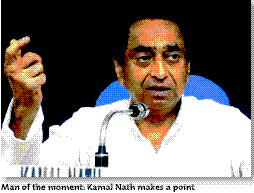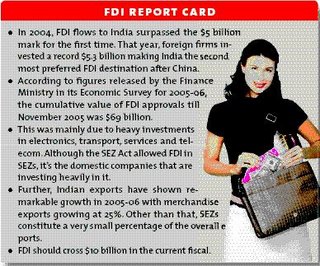IIPM-4Ps and B&E Editorials
Almost everyday, a Special Economic Zone comes up. Policy makers are evidently happy and are encouraging more such zones. However, the equally crucial infrastructural and administrative bottlenecks persist.
Consequently,there’s a touch of the obsessive about the SEZs. Touted as the magic potion, can they deliver? Will they overcome the pitfalls that kayoed earlier projects?
Union Minister

for Commerce
and Industry Kamal Nath must be a happy man. And why not! His hopes of attracting investments to the tune of $100 billion for the setting up of Special Economic Zones (SEZs) appear to be making that crucial move from dream to reality. The decision by the Ennore Port Ltd. (ELT), a public sector company, to jointly set up a huge 2,500-acre SEZ in northern Chennai, with Tidco and Sipcot, is a shot in the arm for Nath. It marks an important milestone for the United Progressive Alliance government which has made all efforts to obsessively pursue what the previous six-year-old government of the National Democratic Alliance began.
Yet, despite this sudden rush of real estate developers, who seem to be racing to grab every possible chunk of land to turn it into SEZs, we need to look closely at how much difference the SEZs will really make to the Indian economy, especially the export sector. And much because the current trend seems more like a bumper harvest for real estate developers and enterprises eyeing lucrative tax holidays, rather than a genuine matter of enthusiasm for exporters. The SEZ Act, 2005, was brought forward by the government to replicate the Chinese success story in India. But the Act, which was to boost investments, has many shortcomings in its current form. For example, the government has allowed just 3.9 square miles and 0.039 square miles for multi-product zones and IT, gems & biotechnology zones, respectively.
Contrast this with the findings of
a Morgan Stanley report in June 2006, which states that the minimum size of a SEZ should be somewhat between 40-50 square miles. The

difference becomes obvious when one compares these SEZs with Chinese counterparts like Hainan (which is as big as Kerala). “SEZs were set up in order to give facilities that were not there in the other parts of the country. But we have seen that exports are doing well even without SEZs. So, we need to have an open mind and it would be wrong to assume that SEZs are the only option to improve our exports,” says Anjan Roy, Economic Advisor, Federation of Indian Chambers of Commerce and Industry. Other than that, it is also difficult to understand the logic behind setting up numerous SEZs in the interiors of the country.
Unlike China, where SEZs were set up in late 1970s to attract investments,India went ahead with its SEZ policy to improve its exports and not to attract investors. But, considering that the level of infrastructure (especially road transport) is still pathetic in India, one wonders as to how any of the SEZs could be of real help. Further, with exports estimated to grow at a rate of 20% and more in the coming years, ports are under severe pressure. Currently, 12 major ports in the country handle 75% of the total trade traffic, while the remaining 25% is covered by more than 187 small and medium-sized ports.
While no major change in any of the technologies or the setup has been brought about, ports are getting o

verburdened, affecting their traffic flow. Something can be done, but with the prevalent attitude, lack of speed has become a concerning factor. Only recently, the National Maritime Development Programme stressed that in order to boost India’s port infrastructure, the country needs to invest a whopping Rs.607.50 billion in major ports over the next seven years. And without these investments, the Shipping Ministry’s desire to double the current cargo handling capacity of ports over the next five years will remain a dream. But the inefficiency of Indian ports is not the only concern for exporters. It is the lack of coherence in government policy regarding exports that seems to be keeping exporters from showing enthusiasm for SEZs.
For Complete
IIPM-Article, Click on
IIPM-Editorial LinkSource:- IIPM-
Business and Economy, 2006
 Is it still a figment of your imagination? Now no more... Cartier is out with a downright ferocious pen this time. This pen is wild and whacky and equally precious too! Inspired by a live crocodile of Maria Felix, the Mexican actress, this fountain pen sports a pattern of two crocodiles coiled all around it. This pen with a gold-plated nib is priced at Rs.1,65,000 and is sure to bring out the crocodile hunter within you!
Is it still a figment of your imagination? Now no more... Cartier is out with a downright ferocious pen this time. This pen is wild and whacky and equally precious too! Inspired by a live crocodile of Maria Felix, the Mexican actress, this fountain pen sports a pattern of two crocodiles coiled all around it. This pen with a gold-plated nib is priced at Rs.1,65,000 and is sure to bring out the crocodile hunter within you!

 the heroine’s sari clings suggestively to her, and where she flutters her eyelashes and sighs helplessly waiting behind a tree for the hero to find her, are slowly fading away. Of course, like any versatile audience, we Indians enjoy popcorn movies. Sometimes we like unwinding without having to think for three straight hours like, recently, in Golmaal. We enjoy seeing our actors and actresses all dolled up, dancing and gyrating for our entertainment. But we also enjoy movies that massage our grey cells. Realising this, Bollywood is witnessing a spurt of ‘thinking’ movies – increasingly liberal, increasingly rebellious – in mainstream cinema. Take Mani Ratnam’s next project.
the heroine’s sari clings suggestively to her, and where she flutters her eyelashes and sighs helplessly waiting behind a tree for the hero to find her, are slowly fading away. Of course, like any versatile audience, we Indians enjoy popcorn movies. Sometimes we like unwinding without having to think for three straight hours like, recently, in Golmaal. We enjoy seeing our actors and actresses all dolled up, dancing and gyrating for our entertainment. But we also enjoy movies that massage our grey cells. Realising this, Bollywood is witnessing a spurt of ‘thinking’ movies – increasingly liberal, increasingly rebellious – in mainstream cinema. Take Mani Ratnam’s next project.





 gets more convenient with a Visa Card or two in tow. That is why cricket’s ubiquitous celebrity – the baadshah of boisterous – Navjot Singh Sidhu has been caught clean by Visa International to spread the good word about the company’s sponsorship of the imminent ICC cricket tournament. And words are what Sidhu can rattle off at the drop of a hat; not just that, switch on any channel – sports or news – chances are that his rumbustious Sidhuisms are doing the rounds. His quotes and his penchant for witticism (bordering on the corny and the eccentric at times, but nonetheless hilarious!) exemplify his friendly and flamboyant nature. Which is probably why Visa ‘got him’.
gets more convenient with a Visa Card or two in tow. That is why cricket’s ubiquitous celebrity – the baadshah of boisterous – Navjot Singh Sidhu has been caught clean by Visa International to spread the good word about the company’s sponsorship of the imminent ICC cricket tournament. And words are what Sidhu can rattle off at the drop of a hat; not just that, switch on any channel – sports or news – chances are that his rumbustious Sidhuisms are doing the rounds. His quotes and his penchant for witticism (bordering on the corny and the eccentric at times, but nonetheless hilarious!) exemplify his friendly and flamboyant nature. Which is probably why Visa ‘got him’. of August in order to promote holiday packages for the ICC Champions Trophy 2006. Winners who devise the best ‘Sidhuisms’ will get to be at the ICC. All you have to do is shop till you drop and foot the bill with your Visa card, and you’re entitled to take part in the contest. Visa is looking at leveraging Sidhu’s wackiness for added impetus – all this to draw in the crowds. The swashbuckling wordsmith is bound to shore up responses to the company’s initiatives, outdoing Visa’s earlier tie with Sachin. In the meantime, here’s a potential Sidhuism winner for the contest: “Fields and the competitive arena were never meant to be churches!” Howzzat! 4Ps
of August in order to promote holiday packages for the ICC Champions Trophy 2006. Winners who devise the best ‘Sidhuisms’ will get to be at the ICC. All you have to do is shop till you drop and foot the bill with your Visa card, and you’re entitled to take part in the contest. Visa is looking at leveraging Sidhu’s wackiness for added impetus – all this to draw in the crowds. The swashbuckling wordsmith is bound to shore up responses to the company’s initiatives, outdoing Visa’s earlier tie with Sachin. In the meantime, here’s a potential Sidhuism winner for the contest: “Fields and the competitive arena were never meant to be churches!” Howzzat! 4Ps